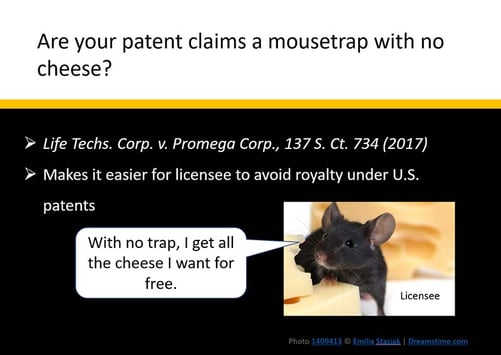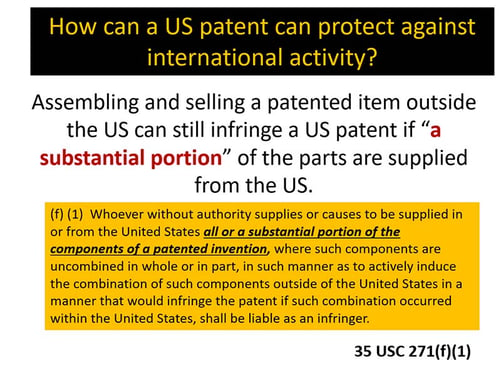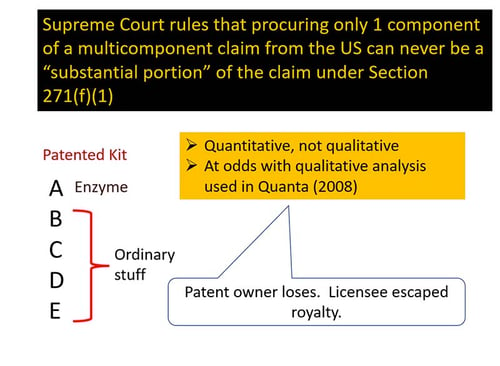 Life Techs. Corp. v. Promega Corp., 137 S. Ct. 734 (2017)
Life Techs. Corp. v. Promega Corp., 137 S. Ct. 734 (2017)
Licensing multi-component inventions sourced only in part in the U.S. creates ample risk that a licensee can avoid paying any patent royalty outside the U.S. The Life Techs. decision explains why this happens.
Promega controlled a patent whose claims protected a kit used for genetic testing. The kit included five components, and the patent claims correspondingly claimed a kit including these five components. One of the components, an enzyme, was technologically special. The other four components were commercially available from sources outside the U.S. Even though, so to speak, only one component of the kit was special while the others were ordinary, all five components were needed for the kit to work.
 Promega licensed Life Technologies under the patent rights to make and sell the kit in the law enforcement field. The license grant was worldwide.
Promega licensed Life Technologies under the patent rights to make and sell the kit in the law enforcement field. The license grant was worldwide.
Life Technologies procured the enzyme from the U.S., where the patent rights were in force, but then procured the other four kit components from international sources. Life Technologies assembled the kits outside the US and then sold them not only outside the US but also outside the authorized field of use. The license grant authorized sales in the law enforcement field, but Life Technologies sold these to clinical and research customers as well. Not only did Life Technologies make sales outside its licensed field, Life Technologies did not pay royalty on these sales.
Clearly, Promega was not happy with these licensee tactics inasmuch as Promega sued Life Technologies for patent infringement. Ordinarily, one expects U.S. patents to protect infringing acts occurring in U.S. territories, not outside the U.S. So, what could have been the basis for Promega to disapprove of what the licensee was doing internationally outside the U.S.? The answer is that Promega turned to 35 USC 271 (f)(1) for protection. Section 271(f)(1) is an interesting piece, as it gives U.S. patent claims some international scope (emphasis added):
35 U.S. CODE § 271.INFRINGEMENT OF PATENT
(f) (1) Whoever without authority supplies or causes to be supplied in or from the United States all or a substantial portion of the components of a patented invention, where such components are uncombined in whole or in part, in such manner as to actively induce the combination of such components outside of the United States in a manner that would infringe the patent if such combination occurred within the United States, shall be liable as an infringer.
 In other words, assembling a combination of components outside the U.S. can still infringe a U.S. patent if a substantial portion of the components were obtained from source(s) in the U.S. Promega sought to ensnare Life Technologies in the combination trap provided by Section 271(f)(1). But Life Technologies procured only the enzyme from the U.S. The other four kit components came from international sources. Was the enzyme that Life Technologies procured in the U.S. a substantial portion of the claimed combination because the other four components were technologically mundane? This seems like a sound proposal, somewhat akin to how the Supreme Court evaluated when components embody essential features of an invention under patent exhaustion law as explained in Quanta Computer, Inc. v. LG Electronics, Inc., 553 U.S. 617 (2008). Promega should go home a winner, right?
In other words, assembling a combination of components outside the U.S. can still infringe a U.S. patent if a substantial portion of the components were obtained from source(s) in the U.S. Promega sought to ensnare Life Technologies in the combination trap provided by Section 271(f)(1). But Life Technologies procured only the enzyme from the U.S. The other four kit components came from international sources. Was the enzyme that Life Technologies procured in the U.S. a substantial portion of the claimed combination because the other four components were technologically mundane? This seems like a sound proposal, somewhat akin to how the Supreme Court evaluated when components embody essential features of an invention under patent exhaustion law as explained in Quanta Computer, Inc. v. LG Electronics, Inc., 553 U.S. 617 (2008). Promega should go home a winner, right?
Sorry, no. Using a somewhat strange, quantitative analysis, the Supreme Court ruled that a single component could never constitute a substantial portion of the components of a multi-component invention. This is unlike its qualitative approach in Quanta and could be confusing to apply in situations where a combination might only include two components. Can a single component ever be a substantial part of a combination including only two components if the Supreme Court analysis is to be taken at its word?
Promega lost the battle, which allowed Life Technologies to do international business in any desired field without incurring any royalty obligation or risk of patent infringement.
What could Promega have done differently to better protect its technology in the U.S. and internationally. Both patenting strategies and agreement strategies could be available, and similar strategies could benefit any patent licensor whose invention involves multiple components:
- The reach and limitations of Section 271(f)(1) should be kept in mind when drafting claims for these kinds of inventions. A patentee could pursue not only combination claims but also methods of using one or more key components. Individual components should be patented if novel and nonobvious.
- Contractual know-how is powerful intellectual property. A patentee like Promega could have crafted a technology deal under which both patent rights and know-how were licensed. In contrast to the relative ease by which patent rights can be avoided, often it is much more difficult for the licensee to avoid contractual know-how. If you are licensor, please do not forget the power of know-how in technology deals. For example, rather than sell the enzyme to the Life Technologies, the enzyme could have been licensed, triggering a worldwide royalty obligation independent of patent rights. The Aronson doctrine and its progeny are of interest in this regard. See Aronson v. Quick Point Pencil Co., 440 U.S. 257 (1979); see also Universal Gym Equipment, Inc. v. Erwa Exercise Equipment Limited.
- A licensor might also look to international protections that might be provided under 35 USC 271(f)(2).
- Although no case law is on point, a licensor could argue that the “having made” right of the U.S. patent is being exercised in the U.S., as the directing actor(s) are in the U.S., and the monies from the accused activity flow into the U.S.

